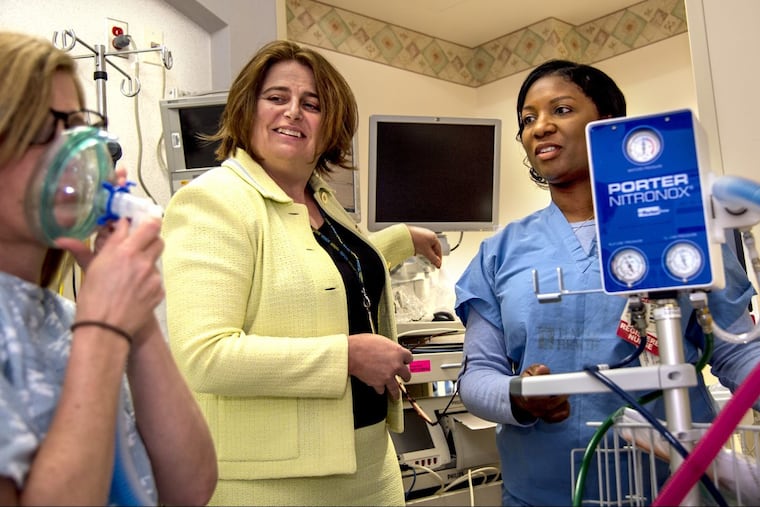Laughing gas makes a comeback for women in labor - like Kate Middleton
A staple of labor and delivery in Europe, nitrous oxide, also known as laughing gas, is catching on in U.S. maternity units and birthing centers.

Nitrous oxide, the "laughing gas" used in many dental offices, is catching on in labor and delivery.
Actually, nitrous is making a comeback in U.S. maternity circles. It has remained a staple of childbirth in Canada, Australia, and Britain — Catherine, Duchess of Cambridge (the former Kate Middleton), who welcomed her third royal baby, Louis Arthur Charles, last month, reportedly has used it. But it basically disappeared in the United States in the 1970s. American women preferred to be numbed below the waist with epidural anesthesia, or at least that became the gold standard for pain relief.
Now, an estimated 500 U.S. hospitals and birthing centers offer nitrous — up from a handful less than a decade ago, according to Porter Instrument in Hatfield, maker of the leading nitrous oxide system.
Midwives and others behind this resurgence emphasize that laughing gas is not anesthesia, unlike epidurals or the other routine aid, opioid painkillers. When nitrous is mixed 50-50 with oxygen and inhaled through a face mask, it makes many women — not all — feel less anxious, more relaxed, and better able to deal with suffering. The gas works by increasing pleasure-signaling brain chemicals such as dopamine.
"In labor, half of the pain is feeling out of control," said obstetrician-gynecologist Laura Goetzl, director of maternal-fetal medicine at Temple University Hospital, which began offering nitrous last month. "Patients have been uniformly positive about having a choice. Some really liked it, some didn't."
"It doesn't take the pain away, but it creates a feeling of euphoria," said midwife Julie Cristol, clinical director of Lifecycle WomanCare and the Birth Center in Bryn Mawr, which blazed the local trail by adding nitrous 13 months ago.
Holy Redeemer Hospital in Meadowbrook also began offering laughing gas for labor last August.
Nitrous has numerous advantages, proponents say. It's simple for the woman to self-administer, takes effect in less than a minute, and wears off just as quickly when she removes the mask and resumes breathing air from the room. It's also safe for the baby, doesn't slow down labor, and can be used at any point — including after the baby's debut if a vaginal tear needs repair.
Indifferent to the agony
Labor pain is no laughing matter, but women who use nitrous offer some funny reviews on blogs.
"I felt the contractions and pain, but felt like I didn't really care," Gemma James wrote on momshood.com. "If they had said they wanted to cut my leg off, I would probably have agreed — well, perhaps not really."
"If your pain is at 100, [nitrous] makes it about a 98, so mainly a distraction," wrote a woman on babycenter.com. "But it worked well for me."
Annette Fisher, 36, of Philadelphia, also used the word "distraction" to describe her use of nitrous last month at Temple. Like many women who start with the gas, she opted for an epidural when her pain intensified.
The advantage, she said, was feeling fully aware of the birth of her daughter Amor — not doped up or groggy as with her first two births.
"I didn't want the narcotic; it basically knocks out the experience," Fisher said. "The gas was very helpful."
Midwives began championing the reintroduction of nitrous about a decade ago. The American Society of Anesthesiologists and the American College of Obstetricians and Gynecologists don't have official positions on its use.
"As midwives, we're always looking for low-tech options, and there aren't many for women in labor," said certified nurse midwife Judith Bishop, an emeritus professor of ob-gyn at the University of California, San Francisco, who has promoted nitrous.
A reassuring safety record
Nitrous comes with some caveats. It can cause nausea and dizziness. It also interacts with vitamin B12, so women with a deficiency of the nutrient shouldn't use the gas, Goetzl said.
But studies — and generations of use worldwide — have not found complications or long-term problems.
Using nitrous to relieve labor pain "is safe for the mother, fetus, and neonate," Judith Rooks, a certified nurse midwife and former government epidemiologist, concluded in a medical literature review published in 2011.
Ironically, about the same time, the only company then making a labor nitrous system folded. Part of the $5,000 system is a machine that scavenges any nitrous from the patient's exhalation so other people in the room aren't exposed to the gas. The set-up also has a disposable face mask and tube.
"We acquired the rights [to the system] and brought it back in 2013," said Michael Civitello, a Porter Instrument salesman.
Since then, two other manufacturers have joined the growing market. While the Philadelphia area is a tiny part of that market so far, several more maternity hospitals are considering nitrous, Civitello said.
Bishop, the San Francisco midwife, said, "I think some hospitals see it as a marketing tool, so if the neighboring hospital has it, they'd better have it."
Insurance plans, however, generally don't cover it. The Birth Center in Bryn Mawr charges patients $25 to try nitrous, and $250 to use it at will during labor. Temple and Holy Redeemer do not charge patients.
"We essentially give it away for free," Goetzl said. "It's really just because you want women to be happier and have higher satisfaction."